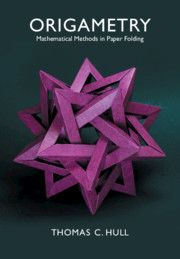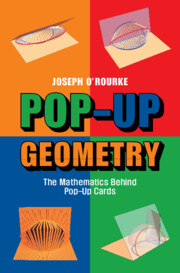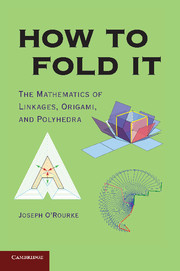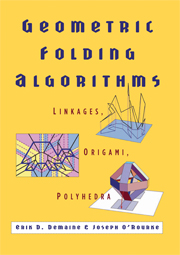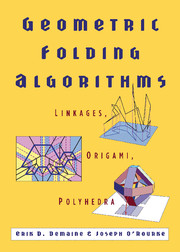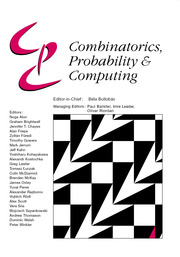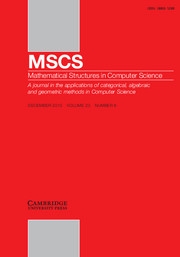Origametry
Origami, the art of paper folding, has a rich mathematical theory. Early investigations go back to at least the 1930s, but the twenty-first century has seen a remarkable blossoming of the mathematics of folding. Besides its use in describing origami and designing new models, it is also finding real-world applications from building nano-scale robots to deploying large solar arrays in space. Written by a world expert on the subject, Origametry is the first complete reference on the mathematics of origami. It brings together historical results, modern developments, and future directions into a cohesive whole. Over 180 figures illustrate the constructions described while numerous 'diversions' provide jumping-off points for readers to deepen their understanding. This book is an essential reference for researchers of origami mathematics and its applications in physics, engineering, and design. Educators, students, and enthusiasts will also find much to enjoy in this fascinating account of the mathematics of folding.
- The first complete reference on the mathematics of origami
- Of interest to professionals and students in mathematics, physics and engineering, as well as educators and origami enthusiasts
- Contains more than 180 figures to illustrate the constructions described
- Numerous 'diversions' provide jumping-off points for readers to deepen and broaden their understanding
Reviews & endorsements
'This is a magnificent, comprehensive work. It gives a thorough overview of the underlying mathematics of flat-facet (polyhedral) origami, bringing together diverse contributions from many investigators (including the author's own seminal work), along with historical notes and context that ties everything together. This will be the standard reference for the mathematics of origami for years to come, and with the plethora of open problems, will also undoubtedly be the inspiration for many master's and Ph.D. theses in the future!' Robert J. Lang, author of Origami Design Secrets and Twists, Tilings, and Tessellations
'Tom Hull has always been the authority and historian on origami mathematics. In this beautiful book, he ties together a wide range of classic and modern results, grounding them in their rich history.' Erik Demaine, Massachusetts Institute of Technology
'Fans of classical geometry, geometry or topology of a combinatorial flavor, and even algebra and analysis will find much to appreciate in this book. Students and instructors alike will discover open problems, elegant theorems, and historical digressions, along with fascinating applications of concepts from standard courses. Origametry could easily function as a sourcebook for further explorations, capstone projects, or original research.' D. P. Tumer, Notices of the American Mathematical Society
'… a delightful and informative read for mathematicians curious about the mathematics behind origami, essential for researchers starting out in this area, and handy for educators searching for ideas in topics connecting mathematics, origami and its applications.' Ana Rita Pires, European Mathematical Society Magazine
'This is not your typical origami book: it is a mathematics text, along with open problems, history, exercises and diversions. It is a good read for both the novice and the expert, and is sure to have something for anyone with even a small interest in the mathematics of origami.' Alan S. McRae, MathSciNet
'This is a wonderfully rich book, which could easily form the basis of an upper-level undergraduate topics course or a graduate seminar. It falls somewhere between a textbook and a research monograph. It has 'diversions' (exercises) throughout, and careful historical notes and open problems at the end of each chapter. I don't see this book being superseded except by its own inevitable second edition.' Joseph O'Rourke, The Mathematical Intelligencer
Product details
October 2020Paperback
9781108746113
342 pages
243 × 170 × 17 mm
0.63kg
22 b/w illus. 165 colour illus. 2 tables
Available
Table of Contents
- Introduction
- Part I. Geometric Constructions:
- 1. Examples and basic folds
- 2. Solving equations via folding
- 3. Origami algebra
- 4. Beyond classic origami
- Part II. The Combinatorial Geometry of Flat Origami:
- 5. Flat vertex folds: local properties
- 6. Multiple-vertex flat folds: global properties
- 7. Counting flat folds
- 8. Other flat folding problems
- Part III. Algebra, Topology, and Analysis in Origami:
- 9. Origami homomorphisms
- 10. Folding manifolds
- 11. An analytic approach to isometric foldings
- Part IV. Non-Flat Folding:
- 12. Rigid origami
- 13. Rigid foldings
- 14. Rigid origami theory
- References
- Index.

